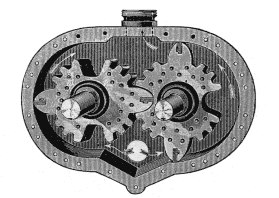Updated: 28 Oct 2007
La France material added






Rotary Steam Engines: Page 7. |
Updated: 28 Oct 2007 |

| Left: The internals of the Silsby rotary steam engine.
The engine and pump were invented by Mr Birdsall Holly. The resemblance to the Pappenheim/Murdoch type of engine is obvious.
The engine and pump were claimed in the same patent by Birdsall Holly.
It is not even easy to work out which is engine and which is pump from this contemporary engraving. I think the the engine is on the right, because the pipe fitting looks too small for the water pump.
Today we have naming of parts. The rotary engine is so compact it is barely visible.
Silsby rotary steam fire-engines were first manufactured in 1856. The rotary pump had been patented the year before by employee Birdsall Holly.
Silsby steamers were highly successful- Silsby was the only firm that built more than 1000 engines. In 1892 the company was merged into the American Fire Engine Company.
|
The rotary water pump was probably a good deal more efficient than the rotary engine that drove it, because the sealing problem is much easier when you are dealing with a viscous fluid like water.
The reign of the rotary steam pump was relatively short. By the late 1800s it had been displaced by the centrifugal pump which required high rotational speeds.
THE LA FRANCE ENGINE
"Business was slow the last year of the Civil War but Truckson La France of Elmira, N. Y. had an idea. He put on his best bowler and went to call on the rich Diven family. "I've perfected a rotary fire engine," he announced. "I want money to make it with." With a snort Old Man Diven gave him the money. Inventor La France made his first fire engine in an old brick house, sold it to Elmira. It was enough to scare the horses, but it had two lines of hose and only one weakness. The cams on the pumps wore down, refused to deliver the pressure. Firemen fixed that by pouring molasses over the cams. For years a jug of molasses was regular equipment on the old "La France."
The Centennial monorail was powered by what was described as a "rotary steam engine of the La France type".
The La France company still exists: see www.americanlafrance.com.

Another fire-engine manufacturer that used rotary engines was La France. This is an extract from an article in Time magazine:
From Time for Monday, Nov 26, 1934.
I do not know for sure, but from the reference to "cams" in the article above, it seems likely that the La France rotary was a Murdoch/Pappeneim-type like the Silsby engine. As for use of molasses as a sealant, I'm not sure if I believe that or not. But it does emphasise one of the many drawbacks of rotary steam engines- their tendency to wear rapidly to the point where operation was seriously affected.

   
|